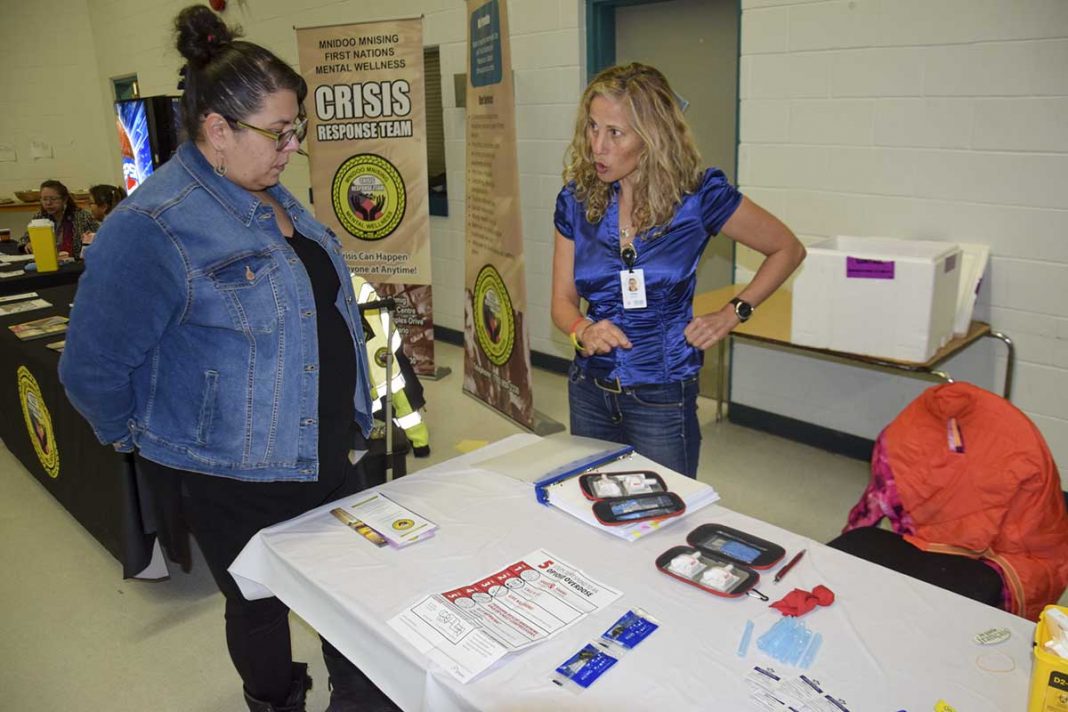M’CHIGEENG – Knowledge is power and the 5th annual National Addictions Awareness Week two-day conference sought to harness greater knowledge of addictions to encourage the conference theme of “Stigma Ends With Me.”
Each day of the conference opened with a continental breakfast and a cleansing smudge ceremony to start off proceedings in a good way.
The first day’s workshops included ‘Beyond the Label—Raising the Spirit’ and ‘Intergenerational Trauma and Substance Abuse’ by Dr. Teresa Naseba Marsh.
The second day’s presentations included a presentation on harm reduction presented by staff from Public Health Sudbury and Districts, ‘Opioid Repacement Disorder Treatment’ presented by Doctor Shruti Sebastian, the newest member of the Central Manitoulin Family Health Team and ‘Land Based Healing’ presented by Gwekwaadziwin Miikan’s Sam Gilchrist.
In addition to the presentations, each day of the conference included workshops in archery, burden baskets, dreamcatchers and yoga.
“Sometimes we only have a one-day conference—this year we are having a two-day conference,” said co-organizer Joan Hoekstra, addiction services initiative caseworker at M’Chigeeng First Nation.
Despite having terrible weather for the first day of the conference, turnout was strong, with over 100 people taking part.
In her presentation on the second day of the conference, Dr. Sebastian took attendees through the various strategies in dealing with addictions, primarily focussing on the use of methadone and suboxone, but also touching on the controlled addictions approach for when the two main strategies do not meet the client’s needs. Everyone’s situation is different and not everyone responds the same to each strategy.
Dr. Sebastian spoke on the importance of integrating addictions treatment into family practices in order to find the way forward for each individual.
Dr. Sebastian explained what opioids are and how each are derived from the opium plant but have different strengths. One slide demonstrated the various strengths of raw opium, morphine, heroin, fentanyl and carfentanyl—the difference is startling and helps to explain how the dangers of the new products appearing on the street manifest themselves.
Carfentanyl is the strongest of the opioids, with only a tiny amount the size of a pin carrying a potentially fatal dose. The drug has begun to appear on the streets in nearby Sudbury and, by extension, can be readily assumed to be present in Manitoulin.
Dr. Sebastian noted that one of the most dangerous times for an addict is actually when they have made an effort to step away from their addictions, whether through treatment or some other route. Human bodies build a tolerance to the drugs and should an addict return to their drug use they very often overestimate their ability to withstand the impact of the drugs—often with fatal consequences. This is a strong argument for safe injection sites, she noted.
“People often try several times before they are successful,” she said of those attempting to beat addiction to opioids. Each time an addict falls back can prove to be fatal, especially if they are alone or with someone who doesn’t know or is unequipped to deal with the overdose.
Despite the stigma attached to addictions, many addicts came to their addictions through prescribed medications as part of a pain control regime following a serious accident or illness.
Some people can manage to deal with the addictive properties of opioids, where others quickly fall into addiction—basically governed by the luck of a genetic draw.
“You can become dependant even if you are in hospital for a week,” said Dr. Sebastian. “Some people will have withdrawal symptoms, but that doesn’t mean they have an addiction.”
When the brain’s “need” for the drug impacts other parts of a person’s life, “where you go out and sell a bunch of your stuff to get it,” dependence becomes addiction.
The issue is a growing one. Data in small communities is more difficult to obtain, noted Dr. Sebastian, but the trends seen in British Columbia tend to make their way here, so the high numbers of overdose deaths seen in the west are quickly becoming apparent here.
“Most people will relapse,” noted the doctor. “The risk of overdose is very high. People go back to what they used before, but their bodies are not tolerant.”
When tackling addiction treatment, Dr. Sebastian said that she focusses on the goals of her patient. “Whatever their goal is, whether it is to regain custody of their child, to get a job, whatever it is, that is my goal—to get them there.”
There are two main strategies based on drug regimes that are used: suboxone and methadone. “For some people, those don’t work and we have to use more specialized alternate approaches,” she said. It is based on managing harm.
Suboxone tends to be safer to use, noted Dr. Sebastian, as it contains naloxone and has virtually no side effects. It also enables the medical professionals to intervene quickly. “With suboxone we can intervene in one to two days,” she said, a critical aspect when someone is in a receptive state such as can happen during an emergency room visit.
Still, with either regime there is a risk of overdose, but it is much higher with methadone than suboxone.
“More and more family doctors are now better trained in dealing with addictions,” she noted. For those seeking to get help in dealing with addictions, a family doctor can be a powerful ally.
The drug and alcohol helplines for those dealing with addictions can be accessed at 1-800-565-8603.




